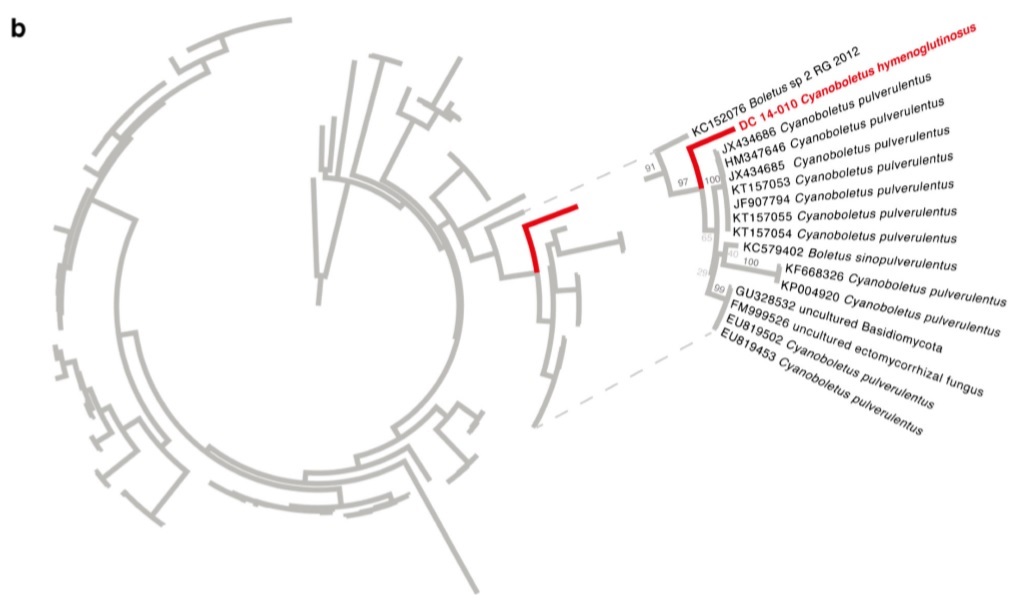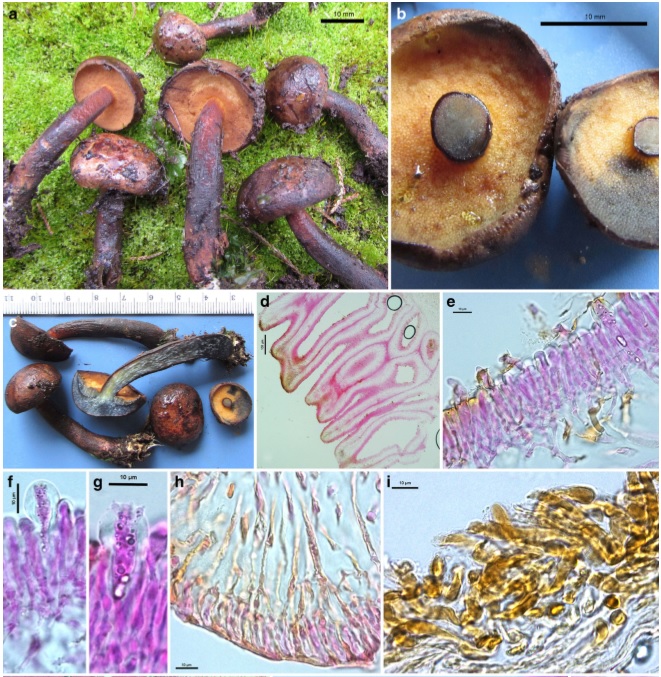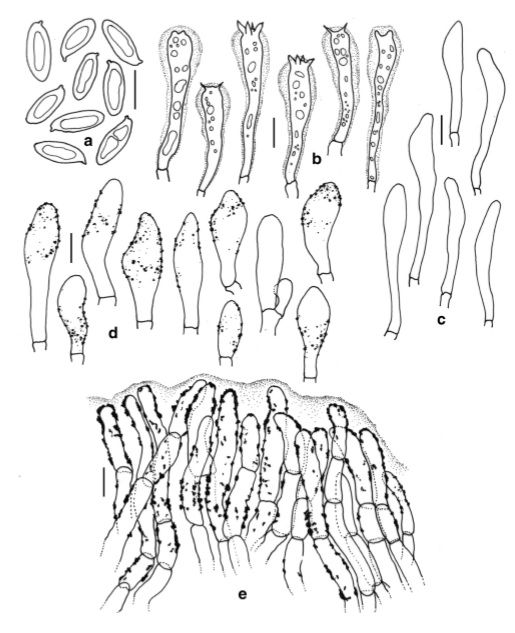Cyanoboletus hymenoglutinosus D. Chakr., K. Das, A. Baghela, S.K. Singh & Dentinger
Index Fungorum number: IF 551541 Facesoffungi number: FoF 02048
Etymology: Named after characteristic highly glutinous hymenium layer
Holotypus: D. Chakraborty & K. Das DC 15-010 (H).
Pileus 16–25 mm in diam.; hemisphaerical when young, becoming convex with maturity; surface rough, highly glutinous, brown (6E5–6) or brownish orange (6C6–7), mostly darker after maturity; margin entire with narrow sterile flap of tissue. Pore surface narrowly depressed near stipe, yellowish orange, orange to greyish orange or brownish orange (5B5–6, 6C5) instantly becoming bluish black (20 F4–5) on bruising; pore2–3 mm, simple, rounded, mostly stuffed. Tube 3–5 mm long, narrowly adnate-sinuate, pale yellow to pastel yellow(1A3–4), becoming bluish black (20F4–5) after bruising. Stipe 50–65×5–8 mm, central, cylindrical, with slightly bulbous base, yellow at apex (near pileus juncture), greyish red (7–8B5) or darker up to black on bruising, surface scalypruinose with longitudinal striations on the upper half, highly glutinous. Context solid (in pileus and stipe); context in pileus pale yellow to pastel yellow (1A3–4), immediately becoming blue on exposure, reddish yellow to melon yellow (4A7–5A6) with FeSO4, but, unchanging colour change with guiacol and KOH. Spore print not found.
Basidiospores 12–15×4.8–5.8μm (x =12.8×5.2, n=20, Q=2.31–2.71–2.79), in equilateral, smooth under light microscope and SEM. Basidia 34–49×6–8 μm, 2–4 spored, clavate to subclavate, covered by very thick gluten. Hymenial cystidia 34–50×5–8μm, emergent 15 –20μm, cylindrical to subfusiform or fusiform, content mostly hyaline, some brown pigmented, mostly associated or partly to completely submerged in gluten. Hymenophoral trama divergent. Pileipellis 65–100 μm thick, ixotrichoderm, composed of erect elements, terminal cell 17–36×6–7μm, mostly with oval to subfusoid apices, brown pigmented, heavily encrusted, wall up to 0.7μm. Stipitipellis 320–340μm, somewhat ixocutis, composed of subrepent to loosely interwoven hyphae submerged under moderately thick gluten, fertile, with caulobasidia and caulocystidia in groups. Caulocystidia 19–48×8–10μm, encrusted, gelatinous.
Habitat and distribution: Under Castanopsis sp. in upper Phadamchen area, humid temperate mixed (broadleaf and coniferous) forests dominated by species of Cryptomeria, Pinus, Castanopsis and bamboos. Producing basidiomata in the rainy season. Uncommon, found in East district of Sikkim (India).
Material examined: INDIA, Sikkim, East district, Upper Phadamchen, 29 July 2014, D. Chakraborty & K. Das, DC 14-010 (holotype, CAL; isotype, AMH).
Notes: LSU sequence data from the holotype (DC 14-010) was added to a dataset consisting of all LSU usedin Wu et al. (2014). Multiple sequence alignment was achieved using the Practical Alignment using Sate and TrAnsitivity (PASTA) algorithm (Mirarab et al. 2014). The resulting alignment was used for maximum likelihood analysis implemented in RAxML v8.1.17 (Stamatakis 2006, 2014; Ott et al. 2007) using a GTRGAMMA model and branch support assessed using rapid bootstrapping set to terminate automatically based on the MRE criterion. The LSU sequence of DC 14-010 was strongly supported (94 % bootstrap) in a clade with Cyanoboletus pulverulentus and three unidentified taxa. The ITS sequence of DC 14-010 was queried against GenBank (Benson et al. 2013) using blastn (Altschul et al. 1990). The top 100 best hits in GenBank were downloaded and combined with the newly generated sequence. Multiple sequence alignment and phylogenetic analysis were carried out as above. Similar to the LSUdataset, DC 14-010 was strongly supported (97 % bootstrap) in a clade composed of multiple sequences from Cyanoboletus pulverulentus, C. sinopulverulentus, and two environmental sequences. Taken together, independent phylogenetic analyses of LSU and ITS sequences unequivocally place DC 14-010 with close affinity to Cyanoboletus spp.
Cyanoboletus hymenoglutinosus is characterized by highly glutinous basidiomata (always associated with mud particles on gluten), yellow- to brown-orange pore surface with stuffed pores, instantaneously changing (to blue-black) pore surface and context, typically highly glutinous hymenial layer, basidia distinctly covered by thick gluten and the apparent association with Castanopsis. Morphologically, Cyanoboletus pulverulentus (Opat.) Gelardi, Vizzini & Simonini (Europe, North America), C. sinopulverulentus (Gelardi & Vizzini) Gelardi, Vizzini & Simonini (similar distribution: China, adjacenttoSikkim,India) and C. rainisii (Bessette&O.K.Mill.) Gelardi, Vizzini & Simonini (North America) look very similar to the present species. But, both C. pulverulentus and C. rainisii lack the typical glutinous pileipellis (cutis in C. pulverulentus and trichoderm in C. rainisii). All three earlier species never shows entirely glutinous hymenial layer and gluten-covered basidia, which is the striking feature of the present species i.e. C. hymenoglutinosus (Smith and Thiers 1971; Bessette et al.2010; Gelardi et al. 2013; Vizzini 2014). Moreover, C. pulverlentus is separated by differently coloured pore surface (Byellow when young, darkening to golden yellow to brownish yellow when mature^ as in Bessetteetal. 2010).Similarly, C. sinopulverulentus has deep yellow pore surface (never with orange pore surface like C. hymenoglutinosus) and unstuffed pores (Gelardi et al. 2013) whereas, in C. rainisii the pore surface becomes dark green (not blue-blak) when bruised and the spores are much larger (10–17×4.2–7μm as mentioned in Bessette et al. 2010).

Phylogenetic placement of the new species Cyanoboletus hymenoglutinosus. a Best maximum likelihood circle phylogram recovered using RAxML of an LSU dataset including the new species Cyanoboletus hymenoglutinosys (DC14-010) and the alignment of Wu et al. (2014). Tree is rooted with Suillus spp. (HKAS57622 and HKAS57748), following the topology of Wu et al. (2014). The clade containing C. hymenoglutinosus is magnified to the left. Numbers on branches are percent nonparametric bootstraps.

Phylogenetic placement of the new species Cyanoboletus hymenoglutinosus. b Best maximum likelihood circle phylogram recovered using RAxML of an ITS dataset including the new species Cyanoboletus hymenoglutinosys (DC14-010) and the 100 best hits on GenBank identified using blastn. Tree is arbitrarily rooted using Xerocomus badius. The Cyanoboletus clade containing C. hymenoglutinosus is magnified at right. Numbers on branches are percent nonparametric bootstraps



